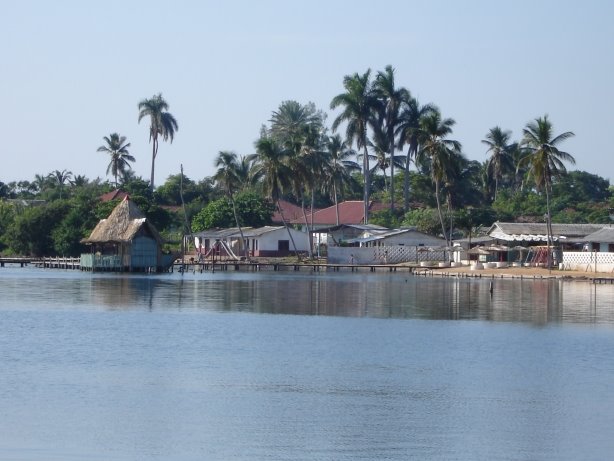
The international project Building coastal resilience in Cuba through natural solutions for adaptation to climate change, will promote an integrated vision of disaster risk reduction and adaptation to climate change as a fundamental basis for the sustainability of development actions by means of direct interventions in four coastal settlements in the country, including Punta Alegre, in the municipality of Chambas.
The project is financed by the European Union, under the program Global Alliance against Climate Change (GCCA by its Spanish initials), and implemented by the United Nations Development Program (UNDP by its Spanish initials) and the CITMA's Environment Agency (AMA by its Spanish initials). The study also includes the Popular Council 2, Punta Brava, of the municipality of Caibarién; Playa Victoria, in the territory of Yaguajay; and Santa Rita, in the town of Nuevitas.
The implementation of natural solutions that allow adjusting to climate change are planned in these areas of the coasts of Villa Clara, Sancti Spíritus, Ciego de Ávila and Camagüey, where the rehabilitation of coasts, the creation of resilient farms, the planning of actions in vulnerable communities and ecosystems, and the incorporation of the integrated approach to disaster risk reduction in local development programs highlight.
“This implies achieving changes in perception, attitudes, management of coastal resources and ancestral customs such as those related to fishing, which require an order, for which it is necessary to form an awareness.
“The strengthening will include equipment, training, visibility, awareness and communication, spaces for coordinating actors at different levels. Special emphasis will be placed on strengthening governments, representatives of key sectors and the media ”, the Master of Science Yamilé Jiménez Peña, Deputy Director of Research at the Bio-food Research Center (CIBA by its Spanish initials) stressed.
At the end of the project, the capacities of key local actors must be created to prioritize actions in the sectoral and territorial Disaster Risk Reduction plans, that not only incorporate the lessons learned from facing extreme hydrometeorological events, but also knowledge about current risks and future ones, reducing existing vulnerabilities and avoiding the creation of new ones.
CIBA documentary sources stand out the impact that the experiment will have on the rehabilitation of coastal wetlands and the contribution to the restoration of protection services of an important stretch of coastal ecosystem. "It will also promote, among key actors and government authorities, the incorporation of natural solutions in development programs, plans and projects to strengthen the resilience of the coastlines."
Building coastal resilience… conceives main activities such as the diagnosis, control and management of exotic and invasive species that affect the ecosystem services of coastal wetlands; the determination and environmental monitoring of polluting sources that affect the environment; and the formulation of proposals for alternatives to solve the environmental impact caused by the dumping of liquid and solid waste.
Specialists from the Territorial Delegation of the Ministry of Science, Technology and Environment (CITMA), the CIBA, the Coastal Ecosystem Research Center (CIEC by its Spanish initials), the Provincial Meteorological Center, the Provincial Directorate of Physical Planning, the Government Municipal People's Power in Chambas, the Agricultural and Hydraulic Utilization companies, the Forest UEB, the University Branch, the Municipal Education Directorate, and prioritized and strategic sectors of the intervened town, including the Fishing Company and Public Health and Education institutions are included to such efforts.
According to the project documentation, national and international environmental agreements recognize that the degradation of ecosystems limits the planet's ability to adapt to climate change and that Ecosystem-based Adaptation (AbE by its Spanish initials) approaches should be a priority. AbE can increase adaptive capacity and social and ecological resilience in developed and developing countries, by using biodiversity and ecosystem services to help people adapt to the adverse effects of climate change.
“This includes the sustainable management, conservation and restoration of ecosystems, as part of a general adaptation strategy, which considers the social, economic and cultural co-benefits for the communities. Some examples are: the restoration of coastal ecosystems to protect communities from storm surges, the use of shade trees in coffee plantations to stabilize production in drier and more variable climates, and the restoration of forests in springs and riparian areas to regulate water reserves and protect communities from flooding.
“AbE can bring additional benefits to adaptation, such as increasing carbon stocks, pollination and diversification of livelihoods. It complements the approaches related to the management of natural resources and biodiversity, but this approach is different because it focuses on adaptive needs and benefits and integrates them into adaptation strategies. Furthermore, AbE focuses on people by using community-based participatory approaches.
“There are many ways to respond to climate change. The important aspect is not to have a list of them, but to understand how each city is affected and what institutional, legislative, community, environmental or infrastructure actions are the most convenient for it to achieve better response capacity or be more resilient to climate change".
